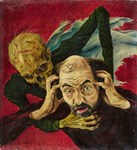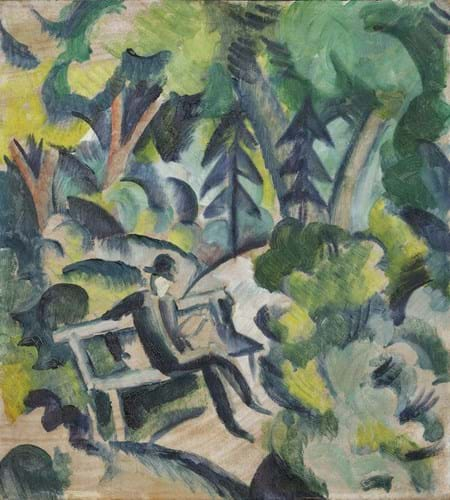
August Macke’s Mann auf Bank (Man on Bench), an oil on cardboard from 1913, was knocked down at Grisebach in Berlin for €900,000 (£775,860).
At Grisebach (25% buyer’s premium) in Berlin, on June 1, a north German collector secured August Macke’s (1887-1914) Mann auf Bank (Man on Bench) a 22 x 20in (56 x 51cm) oil on cardboard from 1913.
Thanks to a preparatory drawing in Macke’s sketchbook it can be dated to the months that the artist spent in a small town on Lake Thun, south of the Swiss capital Berne.
Until 1957, when it was bought by a German collector, it had belonged to the artist’s legacy. Since then, the painting had been in the possession of the collector’s family.
On auction day it was knocked down for a lower-estimate €900,000 (£775,860).
A perennial favourite is Hermann Max Pechstein (1881-1955). His painting of sailing ships from 1922 on offer at Grisebach, which had been in San Francisco since 1997, was titled Sonnenflecken (Sun spots).
It was one of numerous canvases the artist painted during his regular stays at Leba on the Baltic Sea and changed hands for the guide of €400,000 (£344,830).
Tunis and Lake Thun
On June 10, bidders in Berlin had a major surprise for Bassenge (24% buyer’s premium) when a watercolour and pencil drawing by Macke came up for sale with an estimate of €120,000.
The composition also belongs to the works the artist executed in Switzerland just before the outbreak of the First World War. Inspired by the colours he encountered during a trip to Tunis with his colleagues Paul Klee and Louis Moilliet in April 1914, Macke created three watercolours of the garden of the house he was renting near Lake Thun.
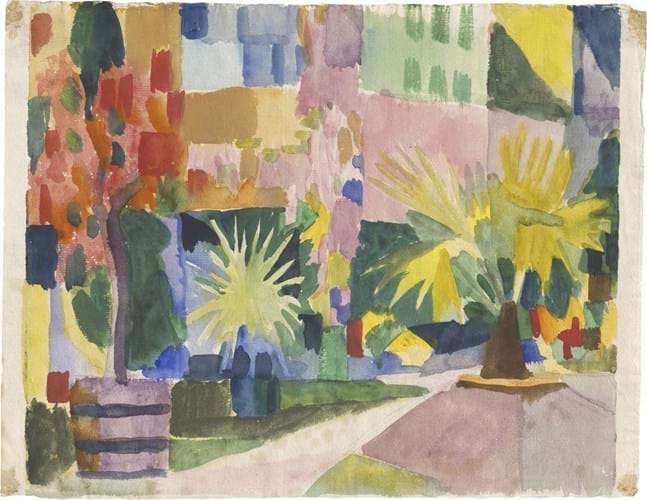
Only a few months before his untimely death in 1914, August Macke painted this watercolour Garten am Thunersee (Garden at Lake Thun) which went for €590,000 (£508,620) at Bassenge in Berlin, almost five times the guide.
Only a few months later, Macke exchanged his idyllic surroundings for the horrors of the trenches. On September 26, he was killed at Perthes-les-Hurlus in Champagne, where he is also buried. These late watercolours are known as Garten am Thunersee (Garden at Lake Thun) and are well documented; two are illustrated in the catalogue raisonné, the third only mentioned and until now, its whereabouts were unknown, before it resurfaced at Bassenge, having been in a private collection since the 1960s, possibly longer.
On auction day, seven phone bidders competed with the room and after a prolonged exchange, a French collector sealed the deal at €590,000 (£508,620).
Gauguin inspiration
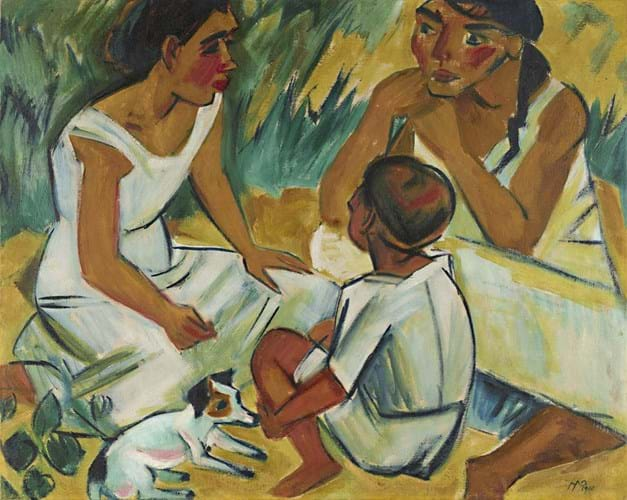
Hermann Max Pechstein was clearly influenced by Paul Gauguin when he painted his Unterhaltung (Conversation) in 1920, which was sold at Van Ham in Cologne for €580,000 (£500,000).
Pechstein also figured prominently at the 500th sale at Van Ham (25/21% buyer’s premium) in Cologne on June 5.
On offer was his 2ft 7in x 3ft 3in (80cm x 1m) composition Unterhaltung (Conversation) from 1920, another of the works he painted while living near the Baltic.
This work was clearly influenced by Paul Gauguin, an artist he had first encountered in Paris in 1907. Pechstein was so fascinated by his art that in 1914, he set off on a long journey following Gauguin’s route to the Palau Islands in the western Pacific.
The outbreak of war, however, put paid to his plans and he had to return to Germany. One of the reasons he spent so much time in the peaceful Baltic countryside was his efforts to overcome his traumatic war experiences.
After a brief exchange of bids, Unterhaltung was knocked down to a local collector, bidding online, for €580,000 (£500,000), just shy of the lower guide. Otto Mueller’s Frau und Knabe (Woman and Boy), previewed in ATG No 2595, was expected to make seven figures, but in the event, it was knocked down for €800,000 (£689,655) to an unnamed bidder.
Pechstein delay
Local competitor Lempertz had high hopes for an early work by Pechstein which was due to be sold on June 6.
His Selbstbildnis, liegend (Self Portrait, lying down) from 1909 had a guide of €1.5m.
Shortly before the sale, newspaper reports suggested that the painted was looted art, acquired under dubious circumstances in the 1930s. Even though the auction house could document that the provenance was far less problematic than might have appeared, it withdrew this star lot and will offer it in the autumn.
Munich success
The June 9 sale at Ketterer (25% buyer’s premium) in Munich was by far and away the most successful of the season. Five works went to seven figures, three of which were by Expressionists.
Once again, Pechstein was much in demand. Die Ruhende (Resting Woman) from 1911 suffered the fate on many works of art in 1930s Germany. Until 1934, the painting had belonged to Dr Ismar Littmann, a German-Jewish collector in Breslau but was later ‘acquired’ by the German authorities.
For many decades, it hung in the Nationalgalerie in Berlin. Only in 2022, was it finally restituted to the descendants of Littmann, who now consigned it to Ketterer.
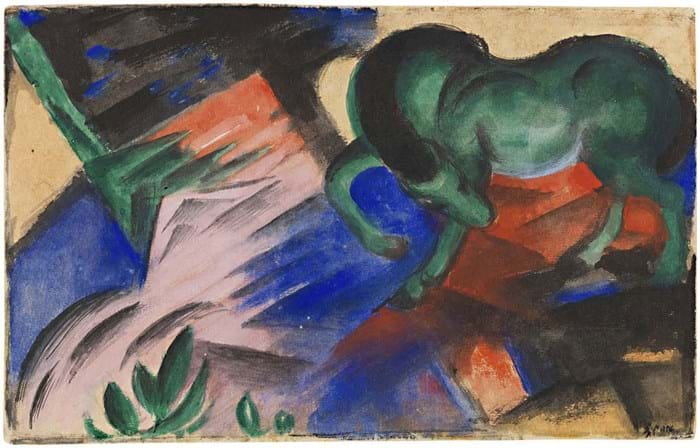
Ketterer in Munich sold Franz Marc’s Grünes Pferd (Green Horse), a tempera from 1912, to a New York bidder for €2m (£1.72m). The preparatory drawing has been in the Guggenheim Museum since 1949.
Estimated at €1.2m, it was sold to a German collector for €1.8m (£1.55m). Another favourite was Franz Marc (1880-1916), who, like Macke, died an early death on the battlefields of France.
Since 1949, a preparatory work for Grünes Pferd (Green Horse) of 1912 has belonged to the Guggenheim Museum in New York.
Ketterer was able to offer the completed 9 x 14in (23 x 36cm) tempera for €600,000. Its provenance could be traced back to 1921, when it belonged to a German-Danish art dealer Herbert von Garvens-Garvensburg in Hanover.
The work is now heading to an as yet unnamed buyer in New York who put up €2m (£1.72m) to claim his prize.
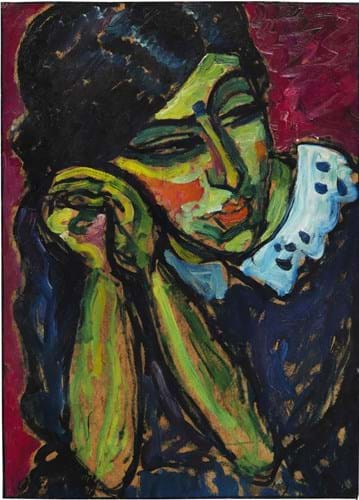
Alexej von Jawlensky’s Mädchen mit Zopf (Girl with Plait), from 1910, took top honours at Ketterer in Munich when it was knocked down to a German collector for €5.3m (£4.57m).
Even this result was overshadowed by the price achieved for Alexej von Jawlensky’s (1864-1941) Mädchen mit Zopf (Girl with Plait), a key work from 1910.
The 2ft 3in x 19in (70 x 50cm) oil had belonged to Clemens Weiler and his wife Ilse from 1957 to 1968. Weiler was the collator of the first catalogue raisonné of Jawlensky’s works.
The Swiss vendor had purchased Mädchen mit Zopf in 2007, when it was sold at Christie’s in New York for $5.193m including premium.
The estimate in München was set at €3.5m. After most of the competitors had dropped out, it was left to two collectors to fight it out. Some 15 years ago, one of them, from the lower Rhine area, had purchased Emil Nolde’s painting Nadja from 1919 for €2.15m. That was the first occasion that Ketterer had sold anything for more than €1m.
The collector remained true to form and eventually outpaced his rival, albeit at a considerable price: the hammer fell at €5.3m (£4.57m), the third-highest price for a Jawlensky and the highest price ever achieved at Ketterer.



